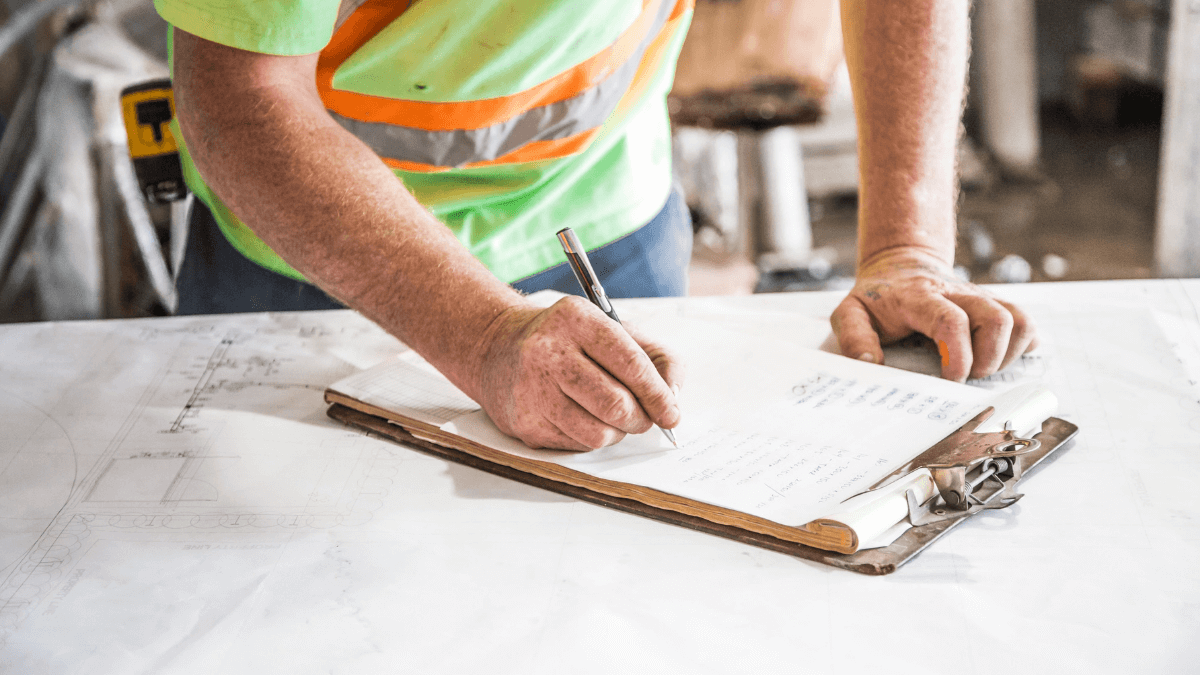If you’re a construction company owner or manager interested in how QR codes can be used to track assets like tools and equipment, look no further.
Although many other asset-tracking methods like GPS, BLE, and RFID are on the market today, QR codes stand out as the simplest and most affordable tracking solution.
In this article, we’ll cover eight ways QR codes enable your business to prevent asset theft and loss, enhance maintenance practices, and streamline operations.
In this article...
Viewing and Updating Asset Data
Before we delve into how QR codes allow workers and managers to view and update asset data, let’s quickly explain how QR code-based asset tracking works.
In essence, such a tracking system is a more advanced (and cost-effective) version of a classic barcode scanning system you see in action when, for instance, a check-out clerk scans the goods you bought with a dedicated scanner.
Now imagine that those traditional barcodes are replaced with quick response (QR) codes, and handheld or fixed barcode scanners are no longer needed because QR codes can be scanned with any smartphone or tablet.

In other words, a QR code-based tracking system includes:
- QR code labels affixed to assets you want to track
- a scanner app to scan QR codes with smartphones or tablets
- cloud-based asset tracking software to process and store the data
Since the only “hardware” you need to purchase (or print yourself) are QR codes, this significantly lowers the upfront costs and simplifies the system setup.
After QR code tags are attached to assets and the software’s database is populated with initial asset data, the tracking system is ready to go.
More precisely, workers and managers can now easily view and update asset data by either scanning the asset’s QR code label or accessing the software’s central asset list to find a specific asset they’re looking for.

For example, this means that a worker on a jobsite can scan a piece of equipment to report a malfunction and request maintenance in a few clicks.
Likewise, they can access the asset database to see if a replacement is available and where it’s located.
Long story short, the ability to quickly access relevant asset data and digitally record any asset-related actions on the spot generates considerable time savings and gives construction companies plenty of opportunities to improve operational efficiency.
Checking Assets In and Out
When tools, equipment, and other assets are tagged with QR codes, workers can quickly check assets in and out while ensuring software captures all these actions.
More precisely, a worker (alone or under supervision) can use a tracking app on their phone to check out an asset they will work with and check it back in when they’re done.
For example, when taking one or more tools from a toolroom, a worker will scan their tags, and the tracking software will record who took them and when.
The same will happen when a worker returns those tools.

Furthermore, when managers are planning the allocation of tools and equipment on one or more construction projects, they can add asset-specific notes and set return dates.
In other words, the tracking software can be set to automatically send reminder emails to relevant persons (a worker who checked out an overdue asset or their manager).

The fact that all asset check-out and return actions are recorded in a cloud database—and that workers are aware of it—has an instant positive effect on worker accountability.
More specifically, this simple QR code-enabled feature can save your company a lot of money and headaches by minimizing the number of stolen, misplaced, and carelessly handled assets.
Overall, QR codes enable you to set up an easy, fast, automated asset check-in/check-out system that immediately increases employee accountability and reduces loss and theft.
Tracking Asset Locations
Another highly useful application of QR codes is the ability to track the location of assets.
In other words, when an employee scans a QR code tag and enters the asset’s info page, one of the data points they can update is that asset’s present location.
That way, all other workers and managers can see where tools and equipment are currently located, which saves time and can reduce site-to-site transport costs.
It’s worth noting that most QR code-based tracking solutions will leave it to the user to manually enter the asset’s location if they want.
Although helpful, this still leaves room for human error, record manipulation, or late detection of asset theft.
Conversely, some tracking solutions like GoCodes Asset Tracking automate this step so that the asset’s location is automatically updated every time a QR code is scanned.

More specifically, the GoCodes Asset Tracking tracking app will utilize the GPS function of a device (smartphone or tablet) to scan the QR code to record the asset’s current GPS position and show it on a map.
If an asset is lost or stolen, the software will show you its last-known (last-scanned) location, which can help you find it (when lost) or retrieve it (when stolen).
Naturally, such tracking solutions won’t show your missing asset as a moving dot on screen like active GPS trackers would (if not removed) but can still aid you or authorities in finding it.
To recap, QR codes enable you to track asset locations, which further enhances worker accountability, minimizes the risk of theft, and helps you retrieve lost or stolen assets.
Scheduling Future Maintenance
The next feature enabled by QR codes refers to scheduling future maintenance tasks, allowing your company to ensure that equipment is regularly serviced and kept in good condition.
In other words, you can pick an asset from the central list of assets, select the date when the next service is to be performed, and assign it to the responsible service technician(s).
Of course, your tracking software should enable you to do this quickly and easily in a few clicks, as you can see in this short video:
If you watched it, you also saw that you can set up automatic upcoming service email reminders, which ensure that the assigned service personnel (and their manager) are notified of the imminent upkeep on time.

Simply put, these functionalities allow your company to execute its preventive maintenance plan, which leads to improved regular maintenance, reduced equipment breakdowns, and lower risk of workplace accidents.
To recap, QR codes—in tandem with asset-tracking software—enable you to schedule future maintenance and automate service reminders, both of which are crucial for ensuring that your equipment is well-maintained and running smoothly.
Automating Field Service Requests
Another advantage of using QR codes for asset tracking is that they automate and streamline the process of field workers reporting equipment issues and initiating service requests.
Without QR code-based tracking software, workers would have to call, text, or email office personnel when a piece of equipment breaks down or faces other issues.
Although these methods may seem efficient enough, they can easily lead to oversights and mix-ups because field service requests are not centrally documented or managed.
Conversely, when workers have a smartphone in their pocket, they can simply scan the QR code label on the relevant asset and use the tracking app to make a field service request.

The request message will include the time, date, and GPS location of the scanned asset (automatically) and specific information entered by the worker.
Therefore, this simple function enabled by QR codes gives you a simple and efficient method for your field employees to notify the office, ensuring no service requests are overlooked.
Assigning Employee Work Orders
This QR code application allows managers to assign and track the performance of maintenance work orders and other equipment-related tasks.
For instance, upon receiving a field service request we just covered, the manager can assign a work order to a specific technician (or team) and use the scheduling feature to set up automatic reminders.
Naturally, this task management feature can be used to assign responsibility for other equipment-related tasks, such as equipment inspections, instrument calibrations, or asset transport orders.

Likewise, when the responsible service technician has executed the maintenance work order or another task, they can immediately report it via the tracking app on their phone or tablet.
If necessary, they can also add comments and photos.
In a nutshell, QR codes allow managers to assign employees work orders, ensuring that the responsibility for their performance is always clear.
Doing so helps avoid misunderstandings and streamlines the management of work orders and other tasks.
Tracking Inventory Quantities
The versatility and affordability of QR codes mean they can be used not just to track tools and equipment but also quantities of spare parts and other consumable items needed for smooth construction operations.
Therefore, this quantity-tracking feature enables you and your team to order and restock parts and supplies on time, i.e., establish an automated inventory management system.

As illustrated above, after scanning the QR code on a container/box holding spare parts like cables and filters, workers can record how many items they took or placed in it.
Depending on how many inventory items you want to keep in stock (e.g., 5, 10, 20), the tracking app will send a low quantity alert when that number is reached.
All in all, QR code-enabled tracking of inventory quantities ensures your maintenance staff and other workers will have all the supplies they need to do their jobs.
Performing Asset Audits
Last but not least, QR codes allow your employees to perform asset audits more quickly and easily, saving the auditors a lot of time and effort.
This is first and foremost enabled by activating the audit mode that lets employees scan multiple tools and equipment in one continuous action.

This multi-scanning feature enables employees to update the location of assets present on a construction site (or warehouse) without scanning each asset individually.
Naturally, this facilitates and accelerates the audit process.
Other features of a QR code-based tracking system that help perform asset audits are the tracking software’s central data repository and its reporting and analytics functionalities.
In other words, audits can be done much faster when auditors have all the relevant asset data in one place and can view, filter, analyze it, and generate custom reports.
Overall, these QR code-enabled features make asset audits simpler and faster by automating various audit-related tasks.
Conclusion
In conclusion, these eight QR code-powered asset tracking applications (enabled by a single tracking software solution) can generate numerous advantages for your construction business.
Namely, you can automatically track asset users and locations, schedule, assign, and monitor maintenance tasks, automate service requests, manage work orders, and perform asset audits.
In turn, these abilities will help you reduce asset theft, loss, and poor maintenance and streamline all asset management aspects of your operations, boosting your company’s productivity and profitability.






